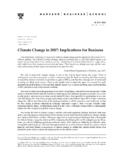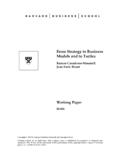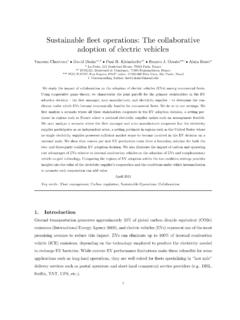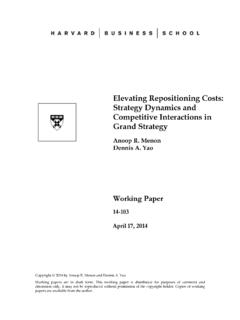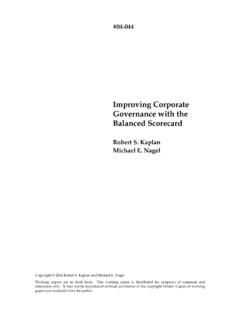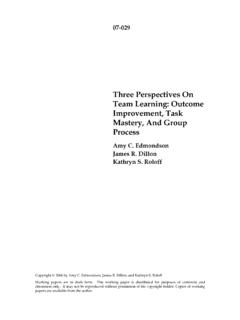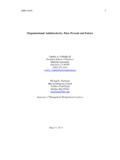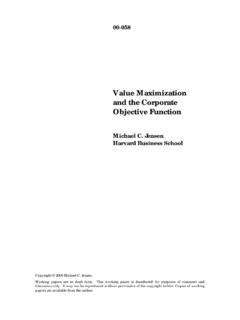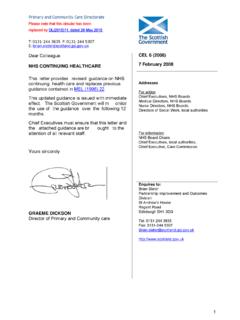Transcription of Change Agents, Networks, and Institutions
1 1 Change Agents, Networks, and Institutions : A Contingency Theory of Organizational Change Julie Battilana harvard University harvard business school Morgan Hall 327 Boston, MA, 02163 Ph. 617 495 6113 Fx. 617 495 6554 Email: Tiziana Casciaro University of Toronto Rotman school of Management 105 St. George Street Toronto, ON Canada M5S 3E6 Phone: (416) 946 3146 E-mail: Authors' names appear in alphabetical order. Acknowledgements: We would like to thank Wenpin Tsai and three anonymous reviewers for their valuable comments on earlier versions of this paper. We also wish to acknowledge the helpful comments we received from Michel Anteby, Joel Baum, Stefan Dimitriadis, Martin Gargiulo, Ranjay Gulati, Morten Hansen, Herminia Ibarra, Sarah Kaplan, Otto Koppius, Tal Levy, Christopher Marquis, Bill McEvily, Jacob Model, Lakshmi Ramarajan, Metin Sengul, Bill Simpson, Michael Tushman and seminar participants at INSEAD, McGill, harvard , Bocconi, and HEC Paris.
2 2 Change AGENTS, NETWORKS, AND Institutions : A CONTINGENCY THEORY OF ORGANIZATIONAL Change Abstract We develop a contingency theory for how structural closure in a network , defined as the extent to which an actor s network contacts are connected to one another, affects the initiation and adoption of Change in organizations. Using longitudinal survey data supplemented with eight in-depth case studies, we analyze 68 organizational Change initiatives undertaken in the United Kingdom s National Health Service. We show that low levels of structural closure ( , structural holes) in a Change agent s network aid the initiation and adoption of changes that diverge from the institutional status quo, but hinder the adoption of less divergent changes. 3 INTRODUCTION Scholars have long recognized the political nature of the Change process in organizations (Frost & Egri, 1991; Pettigrew, 1973; Van de Ven & Poole, 1995).
3 To implement planned organizational changes, that is, premeditated interventions intended to modify the functioning of an organization (Lippitt, 1958), Change agents need to overcome potential resistance from other members of the organization and encourage them to adopt new practices (Kanter, 1983; Van de Ven, 1986). Change implementation within an organization can thus be conceptualized as an exercise in social influence, defined as the alteration of an attitude or behavior by one actor in response to another actor s actions (Marsden & Friedkin, 1993). Research on organizational Change has improved our understanding of the challenges inherent in Change implementation, but it has not accounted systematically for how characteristics of a Change initiative affect its adoption in organizations. Not all organizational changes are equivalent, however.
4 One important dimension along which they vary is the extent to which they break with existing Institutions in a field of activity (Battilana, 2006; Greenwood & Hinings, 2006), defined as patterns which are so taken-for-granted that they are perceived by actors as the only possible ways of acting and organizing (Douglas, 1986). Consider the example of medical professionalism, the institutionalized template for organizing within the United Kingdom s National Health Service (NHS) in the early 2000s. According to this template, physicians are the key decision makers in both the administrative and clinical domains. In this context, centralizing information to enable physicians to better control patient discharge decisions would be aligned with the institutionalized template. By contrast, implementing nurse-led discharge or pre-admission clinics would diverge from the institutional status quo by transferring clinical tasks and decision-making authority from physicians to nurses.
5 Organizational changes may thus converge with or diverge from the institutional status quo 4 (Amis, Slack, & Hinings, 2004; D'Aunno, Succi, & Alexander, 2000; Greenwood & Hinings, 1996). The latter, hereafter referred to as divergent organizational changes, are particularly challenging to implement. They require Change agents to distance themselves from their existing Institutions and persuade other organization members to adopt practices that not only are new, but also break with the norms of their institutional environment (Battilana, Leca, & Boxenbaum, 2009; Greenwood & Hinings, 1996). In this paper, we examine the conditions under which Change agents are able to influence other organizational members to adopt a Change depending on its degree of divergence from the institutional status quo. Because informal networks have been identified as key sources of influence in organizations (Brass, 1984; Brass & Burkhardt, 1993; Gargiulo, 1993; Ibarra, 1993; Ibarra & Andrews, 1993; Krackhardt, 1990) and policy systems (Laumann, Knoke, & Kim, 1985; Padgett & Ansell, 1993; Stevenson & Greenberg, 2000), we focus on how Change agents position in such networks affects their success in initiating and implementing organizational Change .
6 network research has shown that the degree of structural closure in a network , defined as the extent to which an actor s network contacts are connected to one another, has important implications for generating novel ideas and exercising social influence. A high degree of structural closure creates a cohesive network of tightly linked social actors while a low degree of structural close creates a network with structural holes and brokerage potential (Burt, 2005; Coleman, 1988). The existing evidence suggests that actors with networks rich in structural holes are more likely to generate novel ideas ( , Burt, 2004; Fleming, Mingo, & Chen, 2007; Rodan & Galunic, 2004). Studies that have examined the effect of network closure on actors ability to implement innovative ideas, however, have yielded contradictory findings, some having shown high levels (Obstfeld, 2005; Fleming et al.)
7 , 2007), others low levels (Burt, 2005) of network closure to facilitate Change adoption. 5 In this paper, we aim to reconcile these findings by developing a contingency theory of the role of network closure in the initiation and adoption of organizational Change . We posit that the information and control benefits of structural holes (Burt, 1992) take different forms in Change initiation compared to Change adoption, and these benefits are strictly contingent on the degree to which the Change diverges from the institutional status quo in the organization s field of activity. Accordingly, structural holes in a Change agent s network aid the initiation and adoption of changes that diverge from the institutional status quo but hinder the adoption of less divergent changes. In developing a contingency theory of the hitherto underspecified relationship between network closure and organizational Change , we draw a theoretical link between individual-level analyses of network bases for social influence in organizations and field-level analyses of institutional pressures on organizational action.
8 We thus aim to demonstrate the explanatory power that derives from recognizing the complementary roles of institutional and social network theory in a model of organizational Change . To test our theory, we collected data on 68 organizational changes initiated by clinical managers in the United Kingdom s National Health Service (NHS) from 2004 to 2005 through longitudinal surveys and eight in-depth case studies. network CLOSURE AND DIVERGENT ORGANIZATIONAL Change In order to survive, organizations must convince the public of their legitimacy (Meyer & Rowan, 1977) by conforming, at least in appearance, to the prevailing Institutions that define how things are done in their environment. This emphasis on legitimacy constrains Change by exerting pressure to adopt particular managerial practices and organizational forms (DiMaggio & Powell, 1983); therefore, organizations embedded in the same environment, and thus subject to the same institutional pressures, tend to adopt similar practices.
9 Organization members are thus motivated to initiate and implement changes that do not affect their organizations alignment with existing Institutions (for a review, see Heugens & 6 Lander, 2009). Nevertheless, not all organizational changes will be convergent with the institutional status quo. Indeed, within the NHS, although many of the changes enacted have been convergent with the institutionalized template of medical professionalism, a few have diverged from it. The variability in the degree of divergence of organizational changes poses two questions: (1) what accounts for the likelihood that an organization member will initiate a Change that diverges from the institutional status quo; and (2) what explains the ability of a Change agent to persuade other organization members to adopt such a Change .
10 Research into the enabling role of actors social position in implementing divergent Change (Greenwood & Suddaby, 2006; Leblebici, Salancik, Copay, & King, 1991; Maguire, Hardy, & Lawrence, 2004; Sherer & Lee, 2002) has tended to focus on the position of the organization within its field of activity, eschewing the intra-organizational level of analysis. The few studies that have accounted for intra-organizational factors have focused on the influence of Change agents formal position on the initiation of divergent Change and largely overlooked the influence of their informal position in organizational networks (Battilana, 2011). This is surprising in light of well-established theory and evidence concerning informal networks as sources of influence in organizations (Brass, 1984; Brass & Burkhardt, 1993; Gargiulo, 1993; Ibarra, 1993; Ibarra & Andrews, 1993; Krackhardt, 1990).
